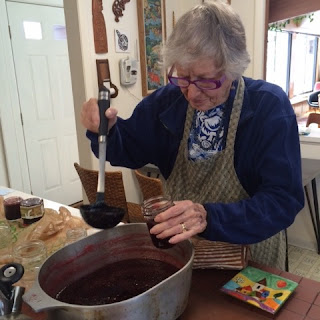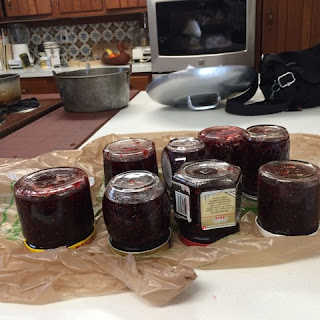Ingredients
2 lbs strawberries sliced or blueberries
1 and ¼ lbs sugar
3 oz fresh lemon juice for strawberries and 4 oz for blueberries (important to use for better preservation)
Lemon: do not use Meyer lemons (not acidic enough)
Directions
Preparing fruit:
Pick unblemished, not overly ripe, high quality fruit. Use V cut to remove stems of strawberries and remove any bruises. Use roughly 2 parts fruit to 1 part sugar by weight. Bathe fruit in water (don’t spray). Best for long-term preservation: low moisture, high sugar, high acidity.
Preparing jars:
Remove 2-part lid off new jars (note: lids are 1-use only; rims and jars are reusable). Be careful not to touch the sterile lids. Place the jars upright on a cookie sheet lined with a towel. Heat oven to 300F and turn oven off after a few minutes after placing jars in the oven. Keep the jars in the hot oven until ready for filling.
To sterilize jars and rims that have been previously used, place clean ones in a 250F oven on a towel-lined baking sheet for at least 30 minutes (keep in oven until ready for filling as above). Both jam and jars should be hot when filling.
Processing jars:
Have a pot of boiling water to clean cloths and scoop and another tall pot of boiling water for sterilizing jars. Fill jars leaving ¼ inch at the top (up to middle line) using metal scoop sterilized briefly in boiling water [can leave scoop in pot]. If you notice a spiral at the top of the jars, fill just to the middle of the spiral. Place lids on, tighten screw tops just a bit, wipe rims with a clean damp cloth dipped in boiling water, and place them gently in the tall pot of boiling water. Water level in pot should be about 3 inches above top of jars. Process the jars for 20 minutes. Carefully pick up jars with tongs without tipping sideways and tighten lids. Place on a towel-lined counter or cookie sheet. Tap whole tray hard to release any air in jars. Allow to cool for 12-24 hours (without disturbing or jiggling them or wiping off water) at room temperature before stacking and listen for the sound of popping (can happen over hours). The top of the lid should be curving very slightly inwards in the middle. Keep in cupboard for about 1 year. If any jars are not sealed, it’s ok to keep in the fridge for a few weeks.
Cooking the Jam
Place the cut-up strawberries (or blueberries), sugar, and lemon juice in the large copper or other pot (at least 12 quarts). Cook over medium heat until it begins to simmer and foam. Size of fruit pieces will determine chunkiness of jam. If there’s any resistance or sticking on the bottom, lower temperature. Once the mixture begins to foam, turn the heat up and stir continuously for about 20 minutes. As you feel the jam thicken, turn the heat down and stir continuously until you get to the gel stage (see below). Remove from heat and skim off foam.
Testing for Doneness
Spoon test: Pick up about ½ teaspoon of the liquid and roll it around the spoon to cool. Hold the spoon perpendicular at a slight vertical angle. If separate syrups drips form, it’s not done. If the drops run along the bottom edge of the spoon and collect into one big drop, it’s done.
Plate test:
Put a few drops on a cold plate. Run your finger through it and If it builds up like a wall, it’s set. If it runs in front of you and you can write with it, it’s not set.
Implements
-Wide pot (copper is best [cools quickly] or coated cast iron with enamel, or heavy stainless steel, non-reactive); suggested measurements are 11 inches at base, 15 inches at the rim, 5 inches high.
-Tall Pot for boiling jars (water level should be at least 3 inches taller than the tops of the jars)
-Canning jar lifting tongs -Metal scoop (eg, ¼ cup)
-Jam jars
Comments
Note about good strawberries in LA: Temai Farms Farmer John Givens Recommended products: Pomona’s apple pectin
Strawberry preserves:
Recommended book: The Blue Chair Jam Cookbook by Rachel Saunders
Recommended jam pot: could use a dutch oven (do not use a stock pot)
Peach preserves:
Do not use white peaches, white nectarines, or plums (all too watery)
For an herbal infusion: place herbs in a tea bag; mix sugar, fruit, juice, and tea bag together overnight and then cook jam.







